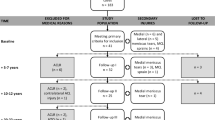Abstract
Purpose
This study investigated variables associated with hip restriction (reduced range of motion) in a group of soccer players presenting with noncontact rerupture of the anterior cruciate ligament (ACL) and compared results with a group of sport-matched healthy professional athletes.
Methods
In this case series, 28 male soccer players with noncontact ACL rerupture were examined for clinical hip range of motion findings potentially associated with ACL rerupture, namely anterior knee displacement, internal–external hip rotation, and cruciate ligament insufficiency. Results were compared with data obtained from 27 healthy professional players. Patients presenting gross surgical errors (e.g. poorly positioned tunnel) or reporting major accidents affecting the lower limbs, such as leg or ankle fractures, were excluded from analysis. Internal–external rotation was measured in the supine position, with knee and hip at 90° of flexion. ACL insufficiency was assessed using the Pivot Shift test and the Lachman’s test with the aid of a Rolimeter RM® arthrometer and confirmed by magnetic resonance imaging.
Results
The most prevalent finding was a significantly lower mean internal–external hip rotation in the rerupture group (45.0°) when compared with healthy professional soccer players (56.2°).
Conclusion
Assessing hip restriction in patients presenting noncontact ACL rerupture showed to be extremely important during ACL reconstruction planning.
Level of evidence
IV.
Similar content being viewed by others
References
Allander E, Bjornsson OJ, Olafsson O, Sigfusson N, Thorsteinsson J (1974) Normal range of joint movements in shoulder, hip, wrist and thumb with special reference to side: a comparison between two populations. Int J Epidemiol 3(3):253–261
Biau DJ, Tournoux C, Katsahian S, Schranz PJ, Nizard RS (2006) Bone-patellar tendon-bone autografts versus hamstring autografts for reconstruction of anterior cruciate ligament: meta-analysis. BMJ 332(7548):995–1001
Boone DC, Azen SP (1979) Normal range of motion of joints in male subjects. J Bone Jt Surg Am 61(5):756–759
Ellenbecker TS, Ellenbecker GA, Roetert EP, Silva RT, Keuter G, Sperling F (2007) Descriptive profile of hip rotation range of motion in elite tennis players and professional baseball pitchers. Am J Sports Med 35(8):1371–1376
Ellera Gomes JL, de Castro JV, Becker R (2008) Decreased hip range of motion and noncontact injuries of the anterior cruciate ligament. Arthroscopy 24(9):1034–1037
Ellera Gomes JL, Palma HM, Becker R (2010) Radiographic findings in restrained hip joints associated with ACL rupture. Knee Surg Sports Traumatol Arthrosc 18(11):1562–1567
Freeman MA, Pinskerova V (2005) The movement of the normal tibio-femoral joint. J Biomech 38(2):197–208
Fuss FK, Bacher A (1991) New aspects of the morphology and function of the human hip joint ligaments. Am J Anat 192(1):1–13
Gerhardt MB, Romero AA, Silvers HJ, Harris DJ, Watanabe D, Mandelbaum BR (2012) The prevalence of radiographic hip abnormalities in elite soccer players. Am J Sports Med 40(3):584–588
Iwaki H, Pinskerova V, Freeman MA (2000) Tibiofemoral movement 1: the shapes and relative movements of the femur and tibia in the unloaded cadaver knee. J Bone Jt Surg Br 82(8):1189–1195
Jacobsen S (2006) Adult hip dysplasia and osteoarthritis. Studies in radiology and clinical epidemiology. Acta Orthop Suppl 77(324):1–37
Philippon M, Dewing C, Briggs K, Steadman JR (2012) Decreased femoral head-neck offset: a possible risk factor for ACL injury. Knee Surg Sports Traumatol Arthrosc. doi:10.1007/s00167-012-1881-1
Prather H, Harris-Hayes M, Hunt DM, Steger-May K, Mathew V, Clohisy JC (2010) Reliability and agreement of hip range of motion and provocative physical examination tests in asymptomatic volunteers. PM R 2(10):888–895
Pugh L, Mascarenhas R, Arneja S, Chin PY, Leith JM (2009) Current concepts in instrumented knee-laxity testing. Am J Sports Med 37(1):199–210
Quatman CE, Quatman-Yates CC, Hewett TE (2010) A ‘plane’ explanation of anterior cruciate ligament injury mechanisms: a systematic review. Sports Med 40(9):729–746
Roach KE, Miles TP (1991) Normal hip and knee active range of motion: the relationship to age. Phys Ther 71(9):656–665
Shimokochi Y, Ambegaonkar JP, Meyer EG, Lee SY, Shultz SJ (2012) Changing sagittal plane body position during single-leg landings influences the risk of non-contact anterior cruciate ligament injury. Knee Surg Sports Traumatol Arthrosc. doi:10.1007/s00167-012-2011-9
Shimokochi Y, Shultz SJ (2008) Mechanisms of noncontact anterior cruciate ligament injury. J Athl Train 43(4):396–408
Souryal TO, Moore HA, Evans JP (1988) Bilaterality in anterior cruciate ligament injuries: associated intercondylar notch stenosis. Am J Sports Med 16(5):449–454
Wordeman SC, Quatman CE, Kaeding CC, Hewett TE (2012) In vivo evidence for tibial plateau slope as a risk factor for anterior cruciate ligament injury: a systematic review and meta-analysis. Am J Sports Med 40(7):1673–1681
Conflict of interest
The authors declare that they have no conflict of interest.
Author information
Authors and Affiliations
Corresponding author
Rights and permissions
About this article
Cite this article
Ellera Gomes, J.L., Palma, H.M. & Ruthner, R. Influence of hip restriction on noncontact ACL rerupture. Knee Surg Sports Traumatol Arthrosc 22, 188–191 (2014). https://doi.org/10.1007/s00167-012-2348-0
Received:
Accepted:
Published:
Issue Date:
DOI: https://doi.org/10.1007/s00167-012-2348-0




